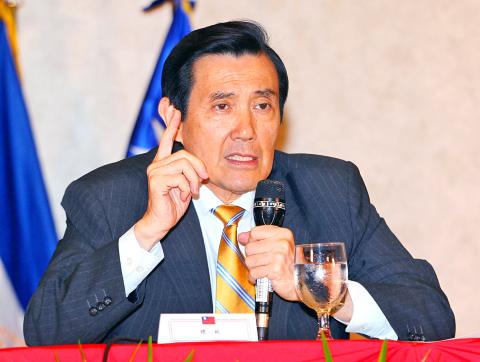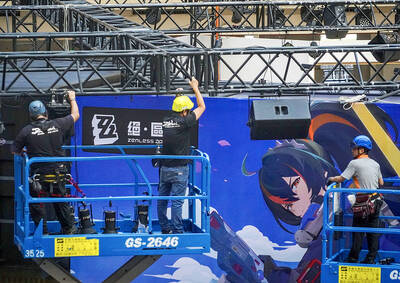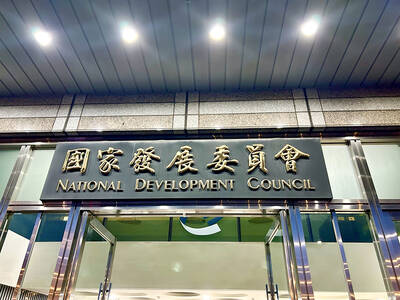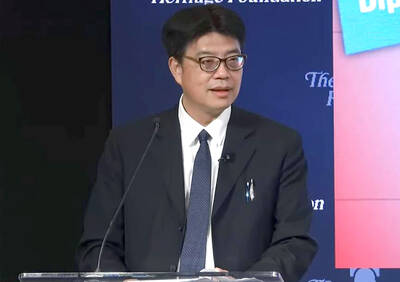President Ma Ying-jeou (馬英九) yesterday emphasized the importance of “peaceful resolution” of a conflict when he commented on the recent landmark change in Japanese Prime Minister Shinzo Abe’s security policy that ends Japan’s long-standing ban on exercising collective self-defense.
In contrast to the immediate support the US has expressed for the decision, the Ma administration has responded to the issue with caution, saying that the government is “closely watching” Japan’s new defense policy.
Given the tense situation in the East China Sea due to territorial rows, it is everyone’s concern that Japan and China could go to war, and if that happens it would certainly implicate the US, Ma said when asked to comment on the issue at a press conference in El Salvador, which was broadcast live from the Presidential Office.

Photo: CNA
Saying that Japan’s new defense policy has drawn disagreement among people in Japan, Ma highlighted the importance of the “principle of peaceful settlement of international disputes” — as stipulated in the UN charter.
“If the principle is not upheld, some dreadful events could be inevitable,” Ma said.
Ma was asked what impact US support for Japan’s new defense policy would bring to cross-strait relations.
The Taiwan Strait is a far more serious flashpoint than the East China Sea, but the US can now rest assured as cross-strait rapprochement continues, Ma said.
The US would surely get involved in the event of a cross-strait conflict, but it would be a very hard problem to resolve even if the US is part of the situation, Ma said.
Ma said he did not characterize the US’ policy of rebalancing toward Asia as a new strategy to contain China, as many people have likened it to the US’ containment policy toward China laid out by former US ambassador to the Soviet Union George Kennan in the 1950s.
The situation today differs from what it was in the 1950s in two respects: first, Asian countries engage with China economically, while relying on the US for security; second, with China rising and Japan having a mind of its own, the US does not have strong advantages in the region as it had back then, Ma said.
Given the situation, Taiwan can play a positive role as it has been doing by pursuing a cross-strait structure of permanent peace, he said.
The agreement Taiwan signed with Japan last year to end controversies over fishing in waters surrounding the disputed Diaoyutai Islands (釣魚台) was a testimony of how the nation has played peacemaker, Ma added.
Meanwhile, Ma reiterated his long-stated wish to meet with Chinese President Xi Jinping (習近平), with a focus on creating a path for both sides to maintain permanent peace and prosperity.
In the normal course of events, the significant changes in cross-strait relations over the years would entail “a meeting between leaders on both sides of the Taiwan Strait,” he said.
Ma said that the suggestion offered by China’s Association for Relations Across the Taiwan Straits Vice Chairman Sun Yafu (孫亞夫) that Taiwan invite Xi for a visit was never brought up for discussion in cross-strait talks.
He said he views an APEC forum as the best venue for a meeting.

Taiwan is projected to lose a working-age population of about 6.67 million people in two waves of retirement in the coming years, as the nation confronts accelerating demographic decline and a shortage of younger workers to take their place, the Ministry of the Interior said. Taiwan experienced its largest baby boom between 1958 and 1966, when the population grew by 3.78 million, followed by a second surge of 2.89 million between 1976 and 1982, ministry data showed. In 2023, the first of those baby boom generations — those born in the late 1950s and early 1960s — began to enter retirement, triggering

ECONOMIC BOOST: Should the more than 23 million people eligible for the NT$10,000 handouts spend them the same way as in 2023, GDP could rise 0.5 percent, an official said Universal cash handouts of NT$10,000 (US$330) are to be disbursed late next month at the earliest — including to permanent residents and foreign residents married to Taiwanese — pending legislative approval, the Ministry of Finance said yesterday. The Executive Yuan yesterday approved the Special Act for Strengthening Economic, Social and National Security Resilience in Response to International Circumstances (因應國際情勢強化經濟社會及民生國安韌性特別條例). The NT$550 billion special budget includes NT$236 billion for the cash handouts, plus an additional NT$20 billion set aside as reserve funds, expected to be used to support industries. Handouts might begin one month after the bill is promulgated and would be completed within

The National Development Council (NDC) yesterday unveiled details of new regulations that ease restrictions on foreigners working or living in Taiwan, as part of a bid to attract skilled workers from abroad. The regulations, which could go into effect in the first quarter of next year, stem from amendments to the Act for the Recruitment and Employment of Foreign Professionals (外國專業人才延攬及僱用法) passed by lawmakers on Aug. 29. Students categorized as “overseas compatriots” would be allowed to stay and work in Taiwan in the two years after their graduation without obtaining additional permits, doing away with the evaluation process that is currently required,

IMPORTANT BACKER: China seeks to expel US influence from the Indo-Pacific region and supplant Washington as the global leader, MAC Minister Chiu Chui-cheng said China is preparing for war to seize Taiwan, Mainland Affairs Council (MAC) Minister Chiu Chui-cheng (邱垂正) said in Washington on Friday, warning that Taiwan’s fall would trigger a regional “domino effect” endangering US security. In a speech titled “Maintaining the Peaceful and Stable Status Quo Across the Taiwan Strait is in Line with the Shared Interests of Taiwan and the United States,” Chiu said Taiwan’s strategic importance is “closely tied” to US interests. Geopolitically, Taiwan sits in a “core position” in the first island chain — an arc stretching from Japan, through Taiwan and the Philippines, to Borneo, which is shared by